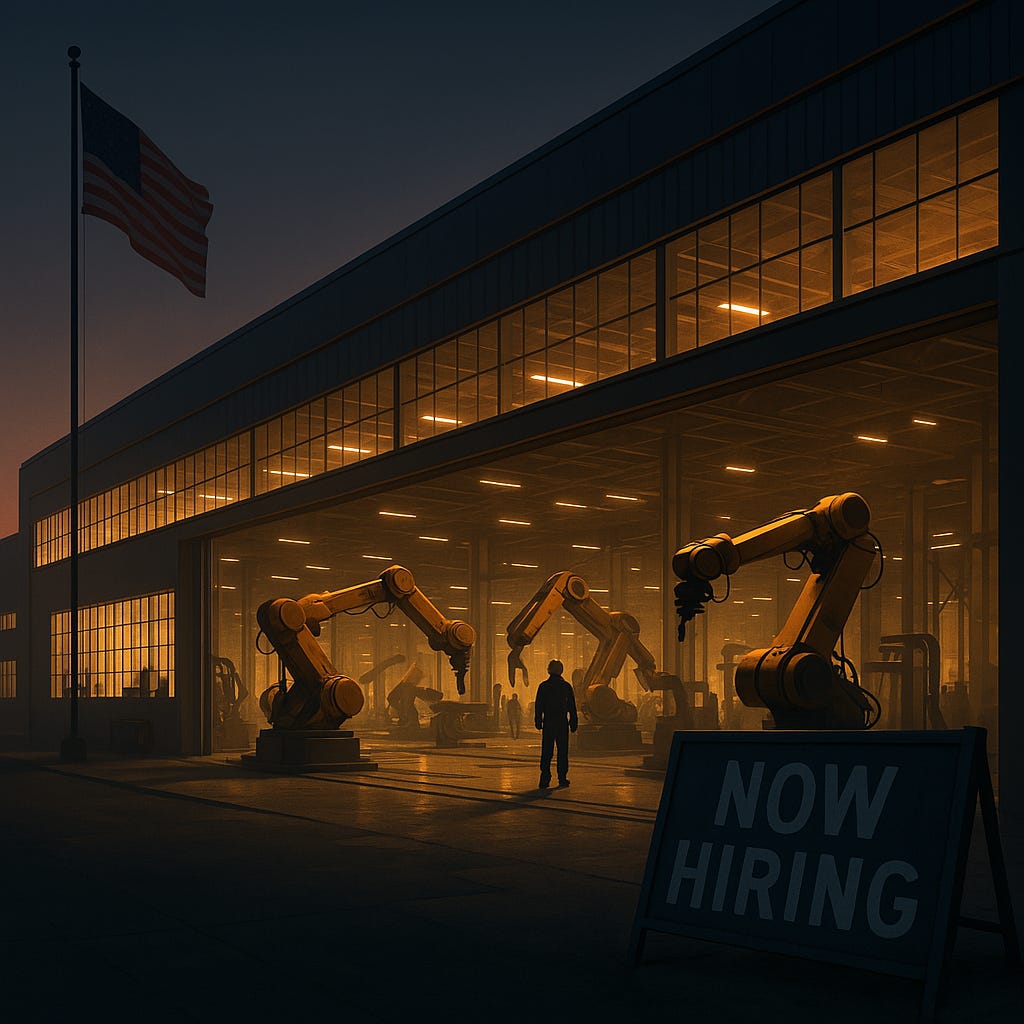Manufacturing Mirage
Why Tariffs and Automation Won’t Bring Jobs Back
Just days after Wall Street's historic market plunge, tensions escalated dramatically. On April 7, 2025, President Trump doubled down, threatening an additional 50% tariff on Chinese imports—potentially hiking total tariffs to an unprecedented 104% if China doesn't back down by April 8.
The reaction was swift and clear: the Dow Jones dropped nearly 350 points, Apple sank 3.7%, and Tesla fell 2.6%. Investors weren't alone in their anxiety; Europe immediately signaled its own countermeasures, proposing 25% tariffs on American goods ranging from diamonds and dental floss to poultry and eggs. A full-scale global trade war no longer seems hypothetical—it's happening right now.
Yet, beneath the chaos of the markets and diplomatic standoffs lies a deeper, more troubling mirage: the idea that aggressive tariffs alone will magically resurrect America's manufacturing jobs. It's a compelling vision, promising factories reopening, steady jobs returning, and communities revitalized. But in reality, this vision glosses over a critical factor—automation.
Today's factories don't look like the bustling assembly lines of the past. Instead, picture sleek, sterile facilities humming quietly with robotic arms, AI-powered quality inspections, and minimal human intervention. Companies pressed to "bring jobs back" to America don't simply replicate their labor-intensive overseas operations here; they modernize, automate, and streamline. Human hands, in this scenario, become fewer and fewer.
Consider Tesla. Even if pressured by tariffs to shift some production away from China, Tesla won't return to traditional methods. Instead, they’ll build highly automated, "lights-out" factories that can operate nearly independently, employing a fraction of the workforce that traditional plants once required.
Apple faces a similar reality. Deeply reliant on Chinese components, Apple's shift would likely push toward automated assembly lines rather than creating substantial new jobs stateside. A sudden move driven by tariffs means speed and efficiency take priority—and robots are faster, cheaper, and more reliable than human workers.
Our podcast, The Future of American Jobs: AI, Automation & Economic Upheaval, dove into precisely this scenario, highlighting how policy decisions designed to bring manufacturing home often fail to account for technological leaps that drastically reduce job creation.
As detailed in our research report, Automation, Tariffs, and Layoffs: The Future of US Manufacturing (2025–2035), tariffs might indeed lead to increased American manufacturing output—but that doesn't translate to significant job growth.
And what about the communities promised a revival? Many towns eagerly awaiting factories may find themselves hosting state-of-the-art facilities employing only a handful of highly specialized technicians. Gone are the hundreds or thousands of blue-collar jobs that once formed the economic backbone of such communities.
Critics—from influential investors like Bill Ackman to tech innovators like Elon Musk—warn that escalating tariffs, combined with unchecked automation, could trigger a recessionary spiral. American families already face rising costs at the grocery store and gas pump; further tariff hikes mean even more financial strain without the benefit of robust employment opportunities.
Policy oversight compounds the issue. Initiatives like the Department of Government Efficiency (DOGE), designed to cut public spending, might inadvertently accelerate this shift by reducing support for critical retraining programs precisely when workers need them most.
If America truly seeks an economic renaissance, policymakers must confront this "manufacturing mirage" head-on. Without targeted policies to support displaced workers, investments in robust retraining initiatives, and careful handling of tariffs to avoid global economic backlash, America risks deepening inequality rather than reversing it.
Who, then, genuinely profits from this scenario? And how do proposed tax reforms amplify the divide between capital owners and everyday workers? These are questions we'll explore in Part 3 of our series: "Rich Get Richer: Trump's Tax Plan, Musk's AI, and the Rise of Inequality."
Stay tuned—and join the conversation. Share your experiences, concerns, and hopes as we navigate these challenging times together.


